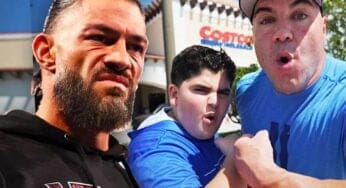Earlier this year, WWE began a campaign featuring QR codes and glitch effects that teased the impending arrival of The Wyatt Sicks. It featured all kinds of puzzles and riddles for fans to solve and now Rob Fee has revealed how it all came together.
While speaking on Dead Meat Presents, Rob Fee explained how the QR codes for the Wyatt Sicks came together, showing just how much freedom and creativity the team had. Hunter trusted him and Bo Dallas to take the lead and gave them the go-ahead to try out wild ideas. Most of the footage was shot at a haunted house attraction called Sir Henry’s Haunted Trail in Plant City, Florida.
“In this one, Hunter just trusted Taylor and me and was like, ‘Go wild with it.’ So we did. It went all over the place. Most of the footage we shot was in this little haunted house.
It was somewhere between Brooksville, which is like my hometown, and Tampa. Oh, Plant City, right? That was it. Yeah, a haunted house—not just allegedly haunted, but more like an attraction. I actually planned on going back this year for Halloween because it was such a cool place, and there was so much material to work with there.
It’s called Sir Henry’s Haunted Trail in Plant City. Big shout-out to them—they let us come in. We were like, ‘Man, we need all these sets for all these different things, like all these locations,’ but we were trying to run this on no budget. We wanted it to look cool and authentic because, as soon as you put a big budget behind it, it’s not scary anymore.”
Operating on a tight budget, they sought a location that felt natural rather than overly polished or corporate. Jeremy Borash suggested Sir Henry’s Haunted Trail, which featured rooms constructed from old, creepy items, giving the space a distinct and unsettling atmosphere. Walking through it felt like stepping into a hundred different sets at once. About 90% of the QR code footage was captured in just one night there.
“Jeremy Borash told us about this haunted house in Plant City. He was like, ‘Their stuff isn’t corporate at all. Their rooms are just built out of old, creepy things.’ So, we checked it out, and walking around in there was like having access to a hundred sets all at once. I’d say about 90% of the QR code footage was shot in one night at that house.”
Fee noted that the whole team was excited to try new ideas. For example, Rob suggested doing a Twitch stream where he wrote letters with hidden codes and coordinates, and the editors immediately got on board. They had full creative freedom and didn’t have to follow strict rules, which let them focus on making the content as creepy and unpredictable as possible.
Triple H wasn’t too involved in the details but supported their ideas. Rob would update him on things like hidden codes in websites, and Triple H would simply encourage them to keep going.
“The whole experience was great. The editors were down for any crazy ideas we had. I told them, ‘Hey, I’m gonna do an hour-long Twitch stream where I write letters, and I’ll need you to glitch up coordinates and codes.’ And they were like, ‘Cool, coming right up.’ The team really got behind everything we wanted to do. It was kind of crazy—nobody was checking on us.
I’d go to Hunter and say, ‘Here’s what we’re doing this week: there’s a code hidden in the HTML page of this thing, and if you follow it, it leads here.’ He was like, ‘Okay, I get it, nerd stuff. Just go do it.'”
Rob Fee further added that the team wanted the project to feel personal for fans. When someone solved a clue, they added that person’s Twitter username into the story, making it more interactive and special. This approach made the project feel unique and engaging rather than just another big, generic production.
“I think that’s what made it feel so creepy and eerie—you didn’t know where the next clue would come from. We even wrote in Twitter users’ names who figured out certain clues. They’d be like, ‘This is me!’ There were so many little personal touches. We wanted it to feel individual instead of just one big, generic project. I think that really came across.”
The QR campaign for the Wyatt Sicks was a big success, and the group is still one of the best parts of WWE shows. Right now, they are feuding with The Final Testament, keeping fans excited. Many are wondering if WWE will use QR codes again in the future since fans really enjoyed the interactive campaign and would love to see it return.
Please credit Ringside News if you use the above transcript in your publication.
What do you think of WWE’s creative direction for the Wyatt Sicks' QR code campaign? Please share your thoughts and feedback in the comment section below.

